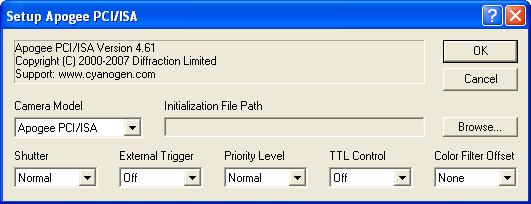
This plug-in driver is available as part of the Obsolete Driver Pack.
For this driver, please select Apogee PCI on the Setup tab.
This driver supports all models including AM, AP, KX, and SPH series operating on PCI interfaces. Please note that older cameras using ISA and parallel port interfaces are no longer supported.
For newer Apogee models please use the separate Apogee USB/Net driver.

When initializing an Apogee CCD camera, MaxIm DL needs information on the parameters of the camera being used. Apogee cameras use a wide variety of detectors, and there are differences in the camera electronics between the various models. This information is obtained from an ”.ini” file that is provided by the manufacturer with the camera. For assistance in setting up INI files please contact Apogee Instruments (http://www.ccd.com).
The Browse… button allows you to select the INI file to use with your camera. The selection sub-dialog appears as shown below. Select the appropriate file and click Open.

Shutter allows you to set shutter options. Normal is the usual setting. Freeze prevents the shutter from moving unless it is switching from dark frame exposures to light frame exposures or vice-versa. Freezing the shutter open increases shutter lifetime when using the camera as an autoguider, but can cause streaking or image saturation.
The External Trigger control enables external triggering of the camera. When enabled and the Expose button is clicked, the camera will wait for the external trigger before starting the exposure. This should be switched off unless the camera is configured for an external trigger.
Priority Level can be set to High to prevent other programs from interrupting the download cycle. This is advisable for high-performance camera models such as the AP7. On some systems, the mouse pointer may freeze during download when the priority is set to High.
TTL Control enables the Apogee TTL Output Control window. Clicking on a button from A through H (trigger port pins 1 through 8) toggles the corresponding Apogee TTL output. Clicking the button on (down) sets the output to a 1; turning the button off (up) sets the output to a 0.
For one-shot color cameras, the Color Filter Offset is used to specify the origin of the color filter pattern that covers the chip. This information is necessary in order for the camera to automatically produce color images. Individual cameras can have the filter pattern offset by one pixel in either or both of the X & Y axes. If automatic color synthesis fails to produces color images that look reasonable, try changing this setting until the color quality improves.
Availability of this feature depends on Product Level.